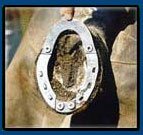UNDERSTANDING THE HORSE
If we are to tame our horse, you must first understand their behavior shows why stubborn?, What motivates you?, What are your needs? ... Only one horse
satisfied you are comfortable with their own, will respond properly to give it orders.
social behavior of horse
The horse is an animal with a tendency to live in packs, in a social group. Like any group, a herd of horses is structured through rules and one of the most important is the hierarchy: Each horse has a position within the group, will be important to know in order to define the characteristics of dressage will need to perform:
mares inherit their rank, they have to fight for it, so you can display them hostile, since two mares have always the same rank.
The male should strive to attain a privileged position in the flock: this gives a much more hard and aggressive, which means some features that we consider in dressage:
Its management to work harder.

rebel with ease.
not accept injustice.
The chief stallion and mare chief live on the same level, without doubt both ranges.
's horse maximum range (leader) can take any other horse in the place where they are, without any reason.
The horse that has a lower rank, can not pass another with greater range. Behind and will do so without complaining. This means that in situations of danger, the herd does not spread, horse senior brand management and the rest will follow. Foals will also
mothers without ever separate them.
The senior horse can push others, the aim of the pack not separate and also to reject sires starting to prevail. This is the reason that the horse is due to rider and that lie outside its visual space for the horse is as if the rider was the stallion that you're pushing.
This hierarchy exists in any horse race and is accepted by all members.
His vision: the horse has a field of view very broad, between 340 º and 360 º, with the following characteristics:
has a blind field, which prevents him from seeing straight ahead of you, about something more than a meter.
Side vision with one eye can not perceive the terrain, so we can rotate the head.
Although misperceives details, is very sensitive to movement.
can see at night.
His ear : the sense of hearing in the horse is highly developed,
can hear sounds imperceptible to humans.
His ears are oriented towards the place where the noise occurred.
His nose: is also a highly developed sense. They can be recognized by this effect, being used by the horse to find his mother.
Their languages: the horse uses different parts of your body along with the sounds to communicate, to know what you want to say to each of these languages:
Ears show the animal's mood:
languid and Falls: means that the horse is not comfortable or is sick.
is also a sign of submission. Erect and moving
: alertness.
straightened and rotated forward: there is something that attracts attention.
Vertical: mean distrust.
One ear forward and one backward: Doubt (may not have understood something of what we are trying to convey during break).
Cola: symbol of energy, their movements also report on the state of horse
up: a sign of joy.
Between the legs, suggests distrust.
Sounds: although the horse does not emit many sounds, we know what each one of them:
snort: when the horse breathes out through his nose, is a symbol of contentment.
Moo: indicates fear or distrust of anything unfamiliar.
Grunt: pain signal.
Screech: It's usually short and sharp, and often the females who issued it, to show his temper (usually when they are in front of another horse). Nickers
: there are plenty of them, but the most common are produced by nervous or when a horse is separated from the rest of the herd, to call their peers.
FLANGED AS A HORSE:
- The steps to bridle a horse are:
L Put the ado left and position the lead horse on the neck of it, to fall to the ground. Hold the flange
left and position the lead horse on the neck of it, to fall to the ground. Hold the flange
the headpiece and between the horse's ears, offering extended left hand, the bit on the lips.
If you do not open your mouth, you must press your thumb on the bars of the mouth, where it should be placed where there is no bite and teeth. Raise the flange and insert the morsel in the mouth, then carefully, and bending the ears forward, put the headpiece on the head. Tense
lace straps and buckles.
To know that is properly installed, you must ensure that between the head and can ahogadero put your hand, while between the noseband and the jaw, you can stick two fingers.
as saddling a horse:
- For correct saddled the horse, follow these steps:

Place the blanket tall at the withers and slide it back to straighten hair below.
Take the chair and make sure the handle is properly seated.
Put the strap through the seat and place it gently on the horse's back, for it should hold the pommel Pesillo front or left hand and right rear. Pull
sweatshirt from the knob to allow air to circulate between it and the horse.
Go to the right side and from there make sure there are no folds in the blanket. Hold
buckle strap on the right.
back to the left, pull the strap from under the horse and fasten the buckle on this side.
HORSE HOW TO TAKE THE HAND:
ahead: The horse must not overtake the person, if you try it will give you a slap on the head. Failure to take action, we will stop and our elbow in the nose. If that does not work, take the horse of a chain that will pull in case of time desobediencia.Una the horse has understood that their position is, we can start doing other exercises, as taught to stop every time we do it. To do this in the first few times the horse will be notified of our stop by a "ho" or "High", later the horse must stop to see that the rider does. This will serve to make the horse more comfortable to wear but what is more important: maintaining the animal's attention focused on the jinete.Después we attempt the same exercise at a trot. We can also teach the horse to go detrás.Guiar the horse from behind: for which we need a rope or reins of such a size let us walk by the back of the horse. In this way we will guide the animal as would the stallion of the herd, pushing. Take the horse in this way, has a fundamental advantage: if the animal perceives danger, instinctively try to run forward, if we can cause some damage there, going behind we avoid this situation.
PLAYING WITH HORSE:
The horse is smarter, more alert and more win will have to play. This also tells us that this is a good horse to work and will surely learn easily, but should exercise their intelligence by playing with him. The game brings many advantages, both for the trainer to the horse
* We provide insight into the characteristics of our animal, we can see during the game moves the horse does not develop at work everyday.
* Assumes a motivation for the horse. Of course, we make clear at the outset what is a game and what work is (for it can, for example, let the horse loose during the game and tie when you need to work.)
* The development of such activities increase the ability of animal care and pay attention in a completely voluntary.
* The game can also be used to train the horse's confidence, for it will place different elements that it can be considered dangerous (such as a ball), of which in principle stay away but soon we will see how fun.
* The freedom to flee from a situation suggests that risk and return on their own initiative is the best way for you to lose your fear. This adds further that if during all these situations the horse is accompanied by her trainer, you could lose the fear of any situation if you notice your presence.
Consider these premises at the time playing with his horse
* Must be you who take the initiative at all times, since otherwise we could be in dangerous situations.
* should not be protected and play without that, however unintentionally, the horse can cause injury.
* We must therefore take a long whip or lash.
* Keep the horse get out of hand, can be extremely dangerous. If you do, you should avoid lean back, as this all I get is that the horse realizes that this move can get overpower, which you can use it later.
POSITION RIDER:
If there is anything due to a tamer, is it a good rider. This is something that not only learn with practice, a good rider as well as knowing it, it is able to adapt this mounted to each horse, as it is able to perceive the state of animal.Básicamente can say that the posture is based on the following points:
Keep your body straight and erect, so never be confused with tense or rigid.
The head should be high.
Legs straight, long, taking special care to stay in constant contact with the horse, preferably throughout its length.
The heels should be lower than the toe.
stoppage in natural position, from the shoulders.
Elbows bent.
fists and relax.
Once we are able to take this position, the next step is to have the temperament to stay focused. When making turns or circles, the horse can destabilize us, something for which we must be fully prepared.
RELATIONSHIP OF TRUST:
If there is something which is essential in training a horse, especially when it is young, is the need to establish a relationship of trust between rider and animal. A job that requires large doses of paciencia.Algunos good advice for achieving this are: --- Let the horse
free in a fenced area. This place should have approximate dimensions of 10 x 6 meters.
--- enter it next to the animal.
--- We speak in a soothing voice, but safe, in low tones. ---
We will approach it, but wait to be the horse who approach us. Once it does give you freedom, leaving us with quiet study, we smell, we analyze ... Once you have taken little more confidence when we will proceed to begin to caress, always in a leisurely, without making any sudden movements that may be scary.
--- A good idea is to give candy or sugar, to make him see that we are their friends. With
these steps, calmly, we will earn your trust, but of course we should not hurry at any time, since that could derail the work andado.Debemos note that if the horse is confident we will be much easier cleaning, attach the computer .... Remember that a horse, especially if young, should never be forced to do something, but convinced to do so.
AWARDS AND PENALTIES:
The system of rewards and punishments is the most commonly used not only for the dressage, but also for many other animals. It is based on certain behaviors associated with unas sensaciones agradables y a otros sensaciones desagradables, que a la larga motivarán al animal a hacer o a dejar de hacer unas y otras.
Lo primero que debemos tener en cuenta es que un caballo puede aceptar un castigo si entiende su por qué; pero nunca lo aceptará sin que se le de una "explicación" (relacionarlo con un comportamiento indebido) y puede llegar a rebelarse.Además, para que un caballo relacione una acción como correcta o inadecuada el premio o el castigo deberán dársele de forma inmediata.
Premios:
Golosinas: que no deberán ser dadas al caballo sin ton ni son, ya que acabaría por ser un vicio. Debemos reservarlas only to acknowledge good behavior and offer them only sporadically.
Breaks: are the optimal award after completing an exercise that has proved hard or dangerous for the horse.
offer security and peace of mind: for this we must be firm but calm, a trainer who screams or sudden movements can make distrust the horse. From there he importance we use a soothing voice, bearing in mind that this animal is highly sensitive to noise. Imitation of behavior
horses: perform movements that develop these animals when they are in a pack can be extremely rewarding for the horse. Some of these are:
* Pass an arm around the neck as they imitate the behavior of the mare when protecting their young and thus provide an important sense of security.
* Scratch behind the ear imitate mutual care offered horses.
* Take your breath on the neck or the nostrils, another mutual care between these animals . Cherish
sensitive points, every horse has some special points which likes to be petted, we look to use as a prize.
Punishment:
Screaming or loud voice we should not abuse them as could get used to the horse, so that only obey to them.
Body language: be upright, gesturing with his arms. Pulled
nose: should be brief but firm.
touches with the whip or lash: these elements should be used as an aid, not to punish the horse because if they take them and afraid to flee can not be used to direct. To punish them give only a brief touch, firm but never beaten. Imitating
punishments carried out by own horses:
* Simulate a kick with a kick.
* Copy a bite, with a blow with his elbow. Finally, it should taking into account that you can not tame a horse if it is not an authoritarian way, as it is in their nature. A time penalty given to prevent loss of control over the horse, but never this punishment must be severe or damage the animal. We must avoid an emotional punishment every punishment should be different, because otherwise the horse will react to wait and allow time to make it effective.





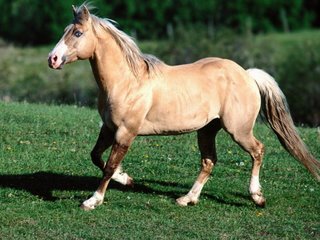
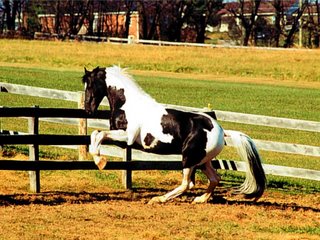
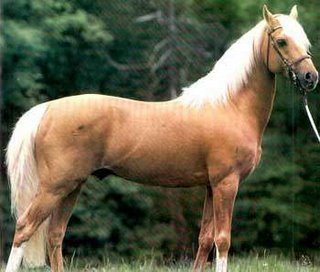
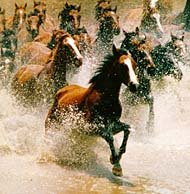


 small
small 






